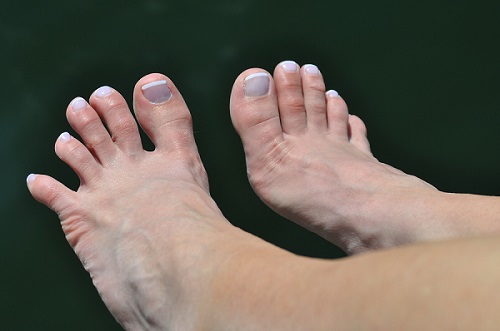
Calluses and Corns
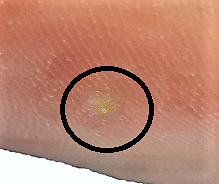
What are Calluses and Corns?
Calluses and corns are thickened areas of the skin. This thickened skin is a response to an area of higher pressure or shear. To protect the skin, the body responds by thickening and hardening it. This prevents damage to the skin, but may create other issues.
The difference between a callus and corn is the corn contains a hardened round spot in the middle of the affected area.
Causes of Calluses and Corns
Footwear
When footwear does not fit properly, excessive pressure and shear may occur. If the shoe is too small, callus or corns may develop on different areas, depending on where the pressure and/or shear occurs. Shoes which are too narrow cause pressure to the inside or outside of the forefoot. If too short, pressure occurs at the tips of the toes. If not deep enough, pressure occurs at the top of the toes. When a shoe is too big, the foot may slide around in the shoe causing a callus or corn at the bottom of the forefoot, either side of the forefoot, or even at the toes. Any other bony prominences on the foot may cause pressure and shear from the shoe if not fitted properly.
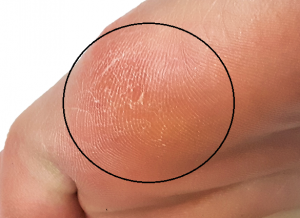
Mechanical
When the foot is moving “abnormally”, higher pressure and/or shear occurs in areas where there would not normally be. The inside of the big toe (hallux) is a common location for callusing due to arch collapse (overpronation) or flat feet (pes planus). Overpronation typically leads to this pressure when pushing/lifting the foot off the ground. With a high arch (pes cavus or supination), pressure typically occurs at the opposite side of the foot, under the border of the outside of the foot. Another common area for pressure is under the forefoot, when the metatarsal arch (ball of the foot) collapses. This exposes the metatarsal heads (bones at the forefoot), and pressure may occur to one or multiple metatarsal heads.
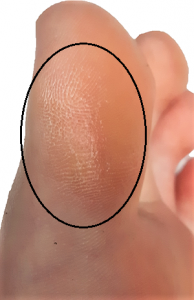
What will I see and feel?
A callus appears as hard, rough and thickened area of the skin. A corn appears as a callus with the addition of a hardened round spot in the middle. If this spot has a black core, it may be a wart. If the skin is dry and flaky, this may be related to other skin conditions.
Although calluses and corns may develop anywhere, common areas are at the ball of the foot, the big toe (hallux) and the heels. The callus or corn may or may not cause pain. It protects the skin from damage, but still presses against other structures underneath.
Treatments
Removal
To remove the callus or corn, there are over the counter options at pharmacies that can be used for mild cases. For more severe calluses or corns, a footcare nurse, podiatrist, or chiropodist are footcare services that remove the calluses or corns professionally. These services are also used for individuals unable to take care of their feet on their own.
Prevention
Before removing the callus or corn, it is important to determine the cause of the skin irritation. If unsure, and the calluses or corns are recurring, this may indicate mechanical pressure from walking or footwear.
Foot Orthotics
Foot orthotics help to offload pressure and/or shear caused by mechanical pressure. Features such as arch support to the collapsed arches, cushioning, or removing pressure directly to the area are used to offload this pressure.
Custom foot orthotics provide a personalized solution to the pressure and pain, which may be important depending on the location of the callus or corn. Over the counter options help offload pressure and shear in some cases. If you are unsure which solution is best for you, it is recommended to speak to a professional.
Footwear
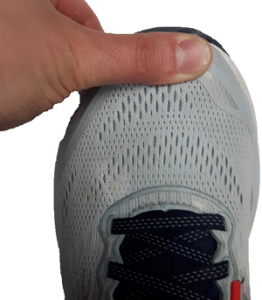
Proper fitting shoes prevent pressure and shear to the factors listed in the “causes” section mentioned above. To fit footwear properly, it is important to look at the length, width and depth.
The length should be spaced about a thumb width (0.5”-0.75”) between the end of the longest toe and the end of the shoe. Be aware that the longest toe may be the second toe. The width should be
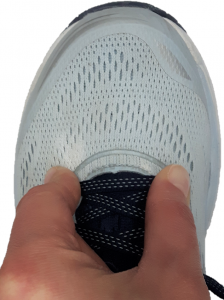
wide enough that the sides of are not bulging out of the shoe. An easy test to do on your own is take the insole out of the shoe and stand on the insole. The widest points of the forefoot should be in line with the corresponding parts of the insole. To determine the depth of the shoe, pinch the material at the end of the laces (towards to toes). The material should have some play, but not enough to grab with both fingers.
There are other features in orthopaedic footwear to help with shoe fit such as stretched areas for bunions, specialized wider widths and depths, difference lace closures and rocker soles.
If you would like more information, feel free to contact us!
You must be logged in to post a comment.

Comments (1)
Pingback: How Diabetics Can Protect Their Feet | On the Ball Orthotics, Barrie